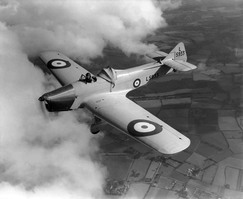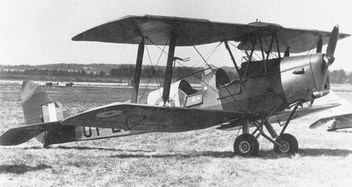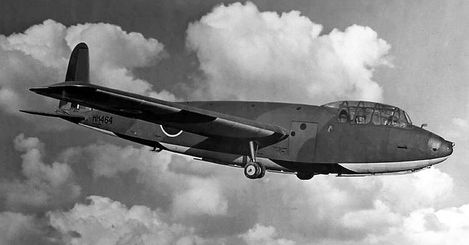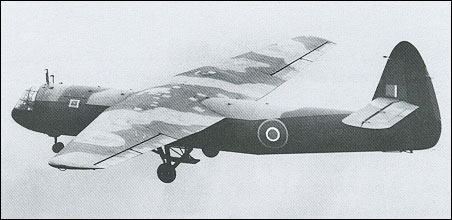Flying Training 1942
May
In May, Lt. Aston was posted to 'D' Flight, No 16 Elementary Flying Training School at RAF Burnaston, nearDerby. This base was used to train glider pilot students to fly light aircraft from January 1942. Several glider pilot students died in accidents while undergoing training at Burnaston and four are buried nearby in St. Wystan’s Churchyard, Repton.
Shortly before the war an RAFVR Flying School had been established alongside Derby Aero Club at the newly built Burnaston airport. The Reserve Flying School (RFS) and airport was run by Air Schools Limited, a civilian company, and several of the civilian ground crew also served in the RAFVR. With the outbreak of war the RFS became No 16 Elementary Flying Training School (EFTS) and the head of Air Schools was re-commissioned as an RAF Officer. The civilian company remained responsible for the operation and maintenance of the aircraft, primarily Tiger Moths and Miles Magisters. In spite of intense training activity, and over 100 aircraft on strength, it achieved the best maintenance record and lowest accident rate of any EFTS.
Whether Lt. Aston received any classroom training before taking his first flight is unknown but very likely. Such training would not show in a flying log. What we do know is that on Thursday, 14 May, accompanied by Flying Officer Webb, he flew for the first time in a Miles Magister aircraft, L8291 for air experience and Part One of his training, understanding the cockpit layout. He had ten minutes of dual control of the aircraft. Lt. Aston was on his way to become a glider pilot.
The next day, Friday 18 May, Lt. Aston was back up with F/O Webb, working on part two of his training, ‘Effects of Controls’. This was across two flights and he saw 55 minutes of dual control. And so the process continued apart from Sundays which saw no flying training.
Over the next few weeks, the training was continuous. The elements of the training were:
May
In May, Lt. Aston was posted to 'D' Flight, No 16 Elementary Flying Training School at RAF Burnaston, nearDerby. This base was used to train glider pilot students to fly light aircraft from January 1942. Several glider pilot students died in accidents while undergoing training at Burnaston and four are buried nearby in St. Wystan’s Churchyard, Repton.
Shortly before the war an RAFVR Flying School had been established alongside Derby Aero Club at the newly built Burnaston airport. The Reserve Flying School (RFS) and airport was run by Air Schools Limited, a civilian company, and several of the civilian ground crew also served in the RAFVR. With the outbreak of war the RFS became No 16 Elementary Flying Training School (EFTS) and the head of Air Schools was re-commissioned as an RAF Officer. The civilian company remained responsible for the operation and maintenance of the aircraft, primarily Tiger Moths and Miles Magisters. In spite of intense training activity, and over 100 aircraft on strength, it achieved the best maintenance record and lowest accident rate of any EFTS.
Whether Lt. Aston received any classroom training before taking his first flight is unknown but very likely. Such training would not show in a flying log. What we do know is that on Thursday, 14 May, accompanied by Flying Officer Webb, he flew for the first time in a Miles Magister aircraft, L8291 for air experience and Part One of his training, understanding the cockpit layout. He had ten minutes of dual control of the aircraft. Lt. Aston was on his way to become a glider pilot.
The next day, Friday 18 May, Lt. Aston was back up with F/O Webb, working on part two of his training, ‘Effects of Controls’. This was across two flights and he saw 55 minutes of dual control. And so the process continued apart from Sundays which saw no flying training.
Over the next few weeks, the training was continuous. The elements of the training were:
SESSION |
SUBJECT |
1 |
Cockpit layout |
2 |
Effects of Controls |
3 |
Taxying |
4 |
Straight & Level Flight |
5 |
Climbing, Gliding & Stalling |
6 |
Medium Turns |
7 |
Take Off |
8 |
Power Approach & Landing |
9 |
Gliding Approach & Landing |
10 |
Spinning |
11 |
First Solo |
12 |
? |
13 |
Precautionary Landing |
14 |
Low Flying |
15 |
Climbing Turns |
16 |
Steep Turns |
17 |
Forced Landing |
18 |
Fire Action & Abandon Aircraft |
19 |
Instrument Flying |
20 |
? |
21 |
Restarting Engine |
22 |
Aerobatics |
23 |
Map Reading |
24 |
Cross Country Dual |
25 |
? |
26 |
Formation |
27 |
Night Flying |
 The Miles Magister Trainer
The Miles Magister Trainer
Some elements had subsets, such as 10. Spinning, where we see left spins or right spins the focus of the flight. It seems that 18. Fire Action & Abandon Aircraft, was often broken across two flights. It may be worth pointing out that the section numbers on the training list were not trained sequentially and several were repeated a number of times.
What the log does tell us is that the Glider Pilots were first and foremost pilots; they would appear not to have had lesser training because they would be flying aircraft without engines.
So back to Lt. Aston. He flew almost every day in May 1942 amassing 10hrs 42mins in the air. As well as physical flying training, on 20 May he was certified in Airscrew Swinging and Understanding Petrol, Oil, Ignition and Cooling System of the Magister aircraft.
Tuesday, 2 June was a red letter day. After an accompanied run through with F/O Pearson, Lt. Aston few solo for the first time. This must have been quite a sense of achievement for a soldier who had never flown in an aircraft until two weeks previously. However, a solo flight makes not the pilot!
What the log does tell us is that the Glider Pilots were first and foremost pilots; they would appear not to have had lesser training because they would be flying aircraft without engines.
So back to Lt. Aston. He flew almost every day in May 1942 amassing 10hrs 42mins in the air. As well as physical flying training, on 20 May he was certified in Airscrew Swinging and Understanding Petrol, Oil, Ignition and Cooling System of the Magister aircraft.
Tuesday, 2 June was a red letter day. After an accompanied run through with F/O Pearson, Lt. Aston few solo for the first time. This must have been quite a sense of achievement for a soldier who had never flown in an aircraft until two weeks previously. However, a solo flight makes not the pilot!
 The DH82 Tiger Moth
The DH82 Tiger Moth
JUNE
June was an intense month for Lt. Aston which resulted in 31hrs 15mins in the air, all flown in a Miles Magister aircraft. Some days contained as many as four separate training sorties and some flown solo.
July
July sees yet more training as Lt. Aston works repeatedly through the various training sessions. A difference this month is that some of the training is done flying a DH82 (Tiger Moth) bi-plane. On 2 July, Aston was certified on Airscrew Swinging & Petrol, Oil, and Cooling System of the DH82. July sees 49hrs 15mins in the air, mostly on the magister aircraft.
August
Flying time in August was much reduced. What practice was done was mostly flying the DH82, still going through the various numbered training sessions. Time in the air was only 7hrs.
June was an intense month for Lt. Aston which resulted in 31hrs 15mins in the air, all flown in a Miles Magister aircraft. Some days contained as many as four separate training sorties and some flown solo.
July
July sees yet more training as Lt. Aston works repeatedly through the various training sessions. A difference this month is that some of the training is done flying a DH82 (Tiger Moth) bi-plane. On 2 July, Aston was certified on Airscrew Swinging & Petrol, Oil, and Cooling System of the DH82. July sees 49hrs 15mins in the air, mostly on the magister aircraft.
August
Flying time in August was much reduced. What practice was done was mostly flying the DH82, still going through the various numbered training sessions. Time in the air was only 7hrs.
 The GA Hotspur Glider
The GA Hotspur Glider
September
The first week or so of this month was regular training on both the DH82 and the Magister, about 7hrs of work. On 8 September Lt. Aston was passed out of ‘D’ Flight 16 EFTS rated as an ‘average’ pilot, fortunately with no special faults to be watched!
By 8 September Lt. Aston was attached to No5 Glider Training School at Shobden Airfield, Herefordshire and was soon airborne. By 30 September he had made 51 flights in Hotspur gliders. Interspersed with these flights was a flight in an Airspeed AS10 Oxford during a navigation exercise on 22 September.
September saw a total of 13hrs 30mins of piloting time.
October
This month's flying began on the first day of the month with an hour on a DH82 brushing up on 7.Take Off, 9.Gliding Approach & Landing and 23.Map Reading. The rest of the flights, 72 in number, were practice exercises in a Hotspur Glider. There was one exception on 23 October when Lt Aston took to the air again in an Airspeed Oxford for navigation training.
This month saw 26hrs 40mins piloting time.
The first week or so of this month was regular training on both the DH82 and the Magister, about 7hrs of work. On 8 September Lt. Aston was passed out of ‘D’ Flight 16 EFTS rated as an ‘average’ pilot, fortunately with no special faults to be watched!
By 8 September Lt. Aston was attached to No5 Glider Training School at Shobden Airfield, Herefordshire and was soon airborne. By 30 September he had made 51 flights in Hotspur gliders. Interspersed with these flights was a flight in an Airspeed AS10 Oxford during a navigation exercise on 22 September.
September saw a total of 13hrs 30mins of piloting time.
October
This month's flying began on the first day of the month with an hour on a DH82 brushing up on 7.Take Off, 9.Gliding Approach & Landing and 23.Map Reading. The rest of the flights, 72 in number, were practice exercises in a Hotspur Glider. There was one exception on 23 October when Lt Aston took to the air again in an Airspeed Oxford for navigation training.
This month saw 26hrs 40mins piloting time.
 The GA Airspeed Horsa Glider
The GA Airspeed Horsa Glider
November
Lt. Aston only flew for four days in November. 2 November saw him make ten flights, 6 November three, 8 November seven and 11 November one flight, all flown in the GA Hotspur glider. The last flight was the completion of a C.I. test. Much of the focus over this month was on night flying; out of the 5hrs 39mins flying time, 3hrs 24mins was night flying, with Aston acting as First Pilot.
However, the Summary of Flying Assessment for the period 18 September to 11 November rates him ‘below average’ as a Glider Pilot and ‘average’ as a Pilot/Navigator. Clearly some work to be done.
December
Like November, Aston had limited days flying, but some were interesting. On 7 December he flew with S/Sgt Mather in Exercise Kingfisher, in a Horsa glider. This is Aston’s first flight in what was to become the workhorse of the Glider Pilot Regiment.
9 December he was flying in an Armstrong Whitley piloted by Wing Commander May, practicing approaches by radio beam. From then until the end of December it was back to the Horsa, managing ten Horsa flights, working through a series of exercises to obtain full familiarity with the aircraft.
Lt. Aston only flew for four days in November. 2 November saw him make ten flights, 6 November three, 8 November seven and 11 November one flight, all flown in the GA Hotspur glider. The last flight was the completion of a C.I. test. Much of the focus over this month was on night flying; out of the 5hrs 39mins flying time, 3hrs 24mins was night flying, with Aston acting as First Pilot.
However, the Summary of Flying Assessment for the period 18 September to 11 November rates him ‘below average’ as a Glider Pilot and ‘average’ as a Pilot/Navigator. Clearly some work to be done.
December
Like November, Aston had limited days flying, but some were interesting. On 7 December he flew with S/Sgt Mather in Exercise Kingfisher, in a Horsa glider. This is Aston’s first flight in what was to become the workhorse of the Glider Pilot Regiment.
9 December he was flying in an Armstrong Whitley piloted by Wing Commander May, practicing approaches by radio beam. From then until the end of December it was back to the Horsa, managing ten Horsa flights, working through a series of exercises to obtain full familiarity with the aircraft.